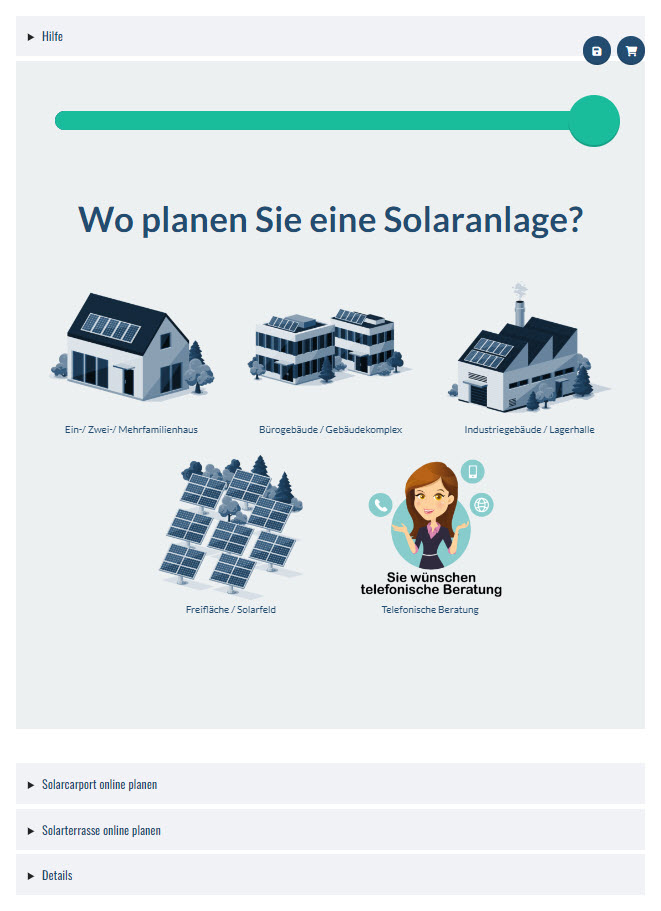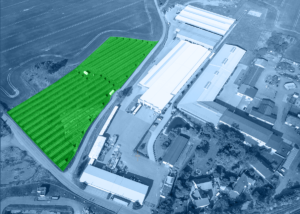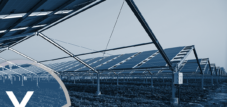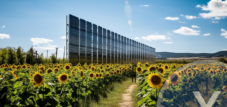Agri-photovoltaics – The missing puzzle for energy economists and agricultural energy: agricultural power generation or electricity generation with agri-PV
Language selection 📢
Published on: October 10, 2022 / update from: August 6, 2023 - Author: Konrad Wolfenstein
Rural energy industry and agricultural energy: Agricultural electricity generation with agri-photovoltaics
When you talk about rural energy management or the use of renewable energies in agriculture, you usually first think of biogas plants. In fact, in the last 10 years, these systems have become more widespread and account for a significant share of renewable energy in agriculture in electricity generation (2021 with 18.45%).
The majority of biomass comes from agricultural residues such as manure, liquid manure and straw. According to the Agency for Renewable Resources (FNR), only a third of the potential is being exploited. In second place in the use of biomass is energy wood, i.e. forest and industrial waste wood as well as waste wood. Two thirds of this potential is already being used.
An important advantage of bioenergy is that it can be stored and compensates for fluctuations in wind and solar energy.
The disadvantages of bioenergy are particularly pronounced when growing biomass. Agricultural land on which energy crops are grown can no longer be used for food and feed production. The increasing demand for biomass is leading to changes in land use. In the long term, this competition can, among other things, make agricultural products more expensive.
Furthermore, biomass is the least efficient use of renewable energy. Their efficiency (that is, the amount of energy produced on a given area) is between 0.5 and 1%. The efficiency of a solar module is around 20%. Wind and solar energy significantly outperform biomass in terms of area efficiency.
Renewable energies - share of energy sources in gross electricity generation 2021

Share of renewable energy sources in gross electricity generation in Germany in 2020 and 2021 - Image: Xpert.Digital
The statistics show the share of renewable energy sources in gross electricity generation in Germany in 2020 and 2021. In 2021, around 7.5 percent of the total gross electricity generation in Germany was produced by biomass.
Share of renewable energy sources in gross electricity generation in Germany 2020
- Wind power (onshore) – 18.40 in %
- Photovoltaics – 8.60 in %
- Biomass – 7.80 in %
- Wind power (offshore) – 4.80 in %
- Hydropower – 3.30 in %
- Municipal waste – 1 in %
- Geothermal energy – 0.04 in %
Share of renewable energy sources in gross electricity generation in Germany 2021*
- Wind power (onshore) – 15.80 in %
- Photovoltaics – 8.80 in %
- Biomass – 7.50 in %
- Wind power (offshore) – 4.30 in %
- Hydropower – 3.40 in %
- Municipal waste – 1 in %
- Geothermal energy – 0.03 in %
*Provisionally.

Partially transparent solar modules for Agri-PV are already in use
Partially transparent solar modules are already being used in a research facility in the “Model Region Agri-Photovoltaics Baden Württemberg”.
More about it here:
Plan your solar system for the most common applications conveniently online with our solar system planner!
With our user-friendly solar system planner you can plan your individual solar system online. Whether you need a solar system for your home, your business or for agricultural purposes, our planner offers you the opportunity to take your specific requirements into account and develop a tailor-made solution.
The planning process is simple and intuitive. You simply enter relevant information. Our planner takes this information into account and creates a tailor-made solar system that meets your needs. You can try out different options and configurations to find the optimal solar system for your application.
Additionally, you can save your plan to review later or share with others. Our customer service team is also available to answer your questions and provide support to ensure your solar system is optimally planned.
Use our solar system planner to plan your individual solar system for the most common applications and advance the transition to clean energy. Start now and take an important step towards sustainability and energy independence!

The solar system planner for the most common applications: Plan the solar system online here - Image: Xpert.Digital
More about it here:
📣 Energy-related renovation and new construction, consulting, planning and implementation for industry, retail and municipalities
Our experienced team will support you in optimizing your buildings to reduce energy consumption and promote sustainable energy use with photovoltaics. We analyze your individual needs and create tailor-made concepts that make sense both economically and ecologically. Regardless of whether it is about the energy-efficient renovation of existing buildings or the construction of new energy-efficient structures, we are at your side. Industrial facilities, retail buildings and municipal facilities can reduce their energy costs and reduce environmental impact while improving the comfort and efficiency of their buildings through our tailored solutions.
👨🏻 👩🏻 👴🏻 👵🏻 Energy-saving renovation and new construction, advice, planning and implementation for private households
We offer comprehensive support for private households in the energy-efficient renovation and construction of new buildings with photovoltaics. Our experienced team is at your side to help you advise, plan and implement your sustainable energy solutions. We analyze your energy consumption, identify savings potential and develop tailor-made concepts to improve your energy efficiency. From improving building insulation to installing energy-efficient windows and doors to installing photovoltaic and solar systems - we accompany you step by step to make your home more energy efficient and environmentally friendly. Trust in our expertise and benefit from the numerous advantages that energy renovation and the use of renewable energies offer you. Together we will create a sustainable future for your home.
Renewable energies - electricity generation in Germany by energy source 2011 and 2021

Renewable energies - electricity generation in Germany by energy source 2011 and 2021 - Image: Xpert.Digital
Biomass performance
In 2011, the share of biomass for gross electricity generation from only renewable energies (124.02 terawatt hours/TWh) was 25.88%. In 2021, the total gross generation of renewable energies was 238 TWh. That's an increase of almost 92% after 10 years. The share of biomass was still 25.88% in 2011. In 2021 the share fell to 18.45%.
Performance of the wind turbines
Onshore wind energy also increased its electricity generation significantly. This is due to the increase in installed capacity, particularly in the years 2014 to 2017. However, in recent years the expansion has declined significantly. The market for offshore wind turbines has also been subject to significant fluctuations recently.
Performance of renewable energy (RE) plants worldwide
Worldwide, the installed capacity of renewable energy systems is increasing every year. Most recently, most of the power was installed in Asia. Europe recorded almost half as much installed capacity as Asia. Among renewable energy systems, hydropower was the energy source with the most installed capacity worldwide.
Gross electricity generation from renewable energies in Germany by energy source in a year-on-year comparison in 2011
- Onshore wind power – 49.20 in terawatt hours
- Photovoltaics – 19.60 in terawatt hours
- Biomass – 32.10 in terawatt hours
- Offshore wind power – 0.60 in terawatt hours
- Hydropower* – 17.70 in terawatt hours
- Household waste** – 4.80 in terawatt hours
- Geothermal energy – 0.02 in terawatt hours
Gross electricity generation from renewable energies in Germany by energy source in a year-on-year comparison in 2021
- Onshore wind power – 92 in terawatt hours
- Photovoltaics – 51.20 in terawatt hours
- Biomass – 43.90 in terawatt hours
- Offshore wind power – 25.30 in terawatt hours
- Hydropower* – 19.70 in terawatt hours
- Household waste** – 5.70 in terawatt hours
- Geothermal energy – 0.20 in terawatt hours
* Generation in run-of-river and storage hydroelectric power plants as well as generation from natural inflow in pumped storage power plants.
** Only produced from the biogenic portion of household waste (approx. 50 percent).
Agri-photovoltaics is the missing piece of the puzzle in agricultural electricity generation
Even if biomass has not developed so much in the last 10 years and has been overtaken by photovoltaics, the storage and availability of biomass remains a decisive advantage over photovoltaics that must be promoted accordingly. It is clear to everyone involved that biomass cannot be expanded to the same extent as solar power generation. A lot can still be achieved with biomass, especially in expanding the existing potential.
Agri-photovoltaics cannot compensate for the disadvantage of poor energy storage. Compared to biomass, there is no comparable magnitude of positive ecological balance with electricity storage. In short: Biomass will always be cheaper for energy storage or storage than electricity storage, which is also reflected in the ecological balance. The ecological balance of electricity storage is only good if the energy used in the production of the electricity storage is saved in the usage process.
The combination and expansion of the functionality of biomass with agri-photovoltaics results in a consolidation and increased potential in agricultural electricity generation!
If all else fails - expansion with agri-photovoltaics
Thanks to transparent solar modules, rural areas with active agriculture have an expanded and cost-effective energy source available. In other words, for areas that actually represent fertile and valuable soil for agriculture and cannot be used for photovoltaic electricity generation, such as open-space systems.
Through the translucence of transparent solar modules, electricity can be generated and at the same time enable the cultivation and cultivation of plants.
The situation is different with systems that are also referred to as open space systems, outdoor facilities or solar parks. The prerequisite for these systems is that profitable agricultural management is not possible when using these areas. These are “disadvantaged areas” in which difficult natural production conditions due to altitude, tendency, climatic conditions, accessibility or poor soil quality rather lead to the task of agriculture than non-disadvantageous areas. Disadvantaged areas are divided into mountain areas, disadvantaged agricultural areas and small areas.
The soil quality or soil fertility (soil points) also plays an important role here. This includes the agricultural comparative number (LVZ). It represents the approximate agricultural or horticultural profitability of a farm according to the Farmland Valuation Act passed on October 16, 1934. LVZ calculations include factors such as soil fertility, general soil conditions, soil quality, climatic conditions and soil irrigation.
If these points and soil conditions are assessed positively and a permit is therefore negative to build a solar park or open-field photovoltaic system on this usable agricultural land, then agricultural photovoltaics becomes interesting as an expanded and potential-enhancing measure. This methodology essentially enables the agricultural area to be utilized twice.
Agri-PV systems / AgriPV: A huge opportunity with agriphotovoltaics for agriculture and the energy transition

Agriphotovoltaics for agriculture and the energy transition – Image: Xpert.Digital / affendi shahidan|Shutterstock.com
Suitable for:
By leveling the EEG, Germany has created the conditions so that AgriPV systems can be built on a broad front and the income can also be compensated. This rethinking is also urgently needed, as as many areas as possible can be used for the further expansion of photovoltaics. Otherwise, the solar expansion goals aimed at for the energy transition in Europe cannot be achieved at all. The dual use of agricultural land is an essential factor for Germany to achieve the desired quadrupling of PV installations in just 7 years to 215 gigawatts by 2030. Approximately 54 GW have been installed in the last 25 years.
A major advantage of decentralized AgriPV systems is that a significant portion of their electricity yield is often used locally, and the grid connection generally does not require as much network expansion as other open-space systems. Two different systems have developed.
☀️🌾🌽🥕🍅🥒 Agri-PV for farmers and municipalities
Everything from a single source, specially designed for solar solutions for large agri-PV systems. You refinance or counterfinance into the future with your own electricity generation.
☀️🍅 For solar engineers
Advice and planning including a non-binding cost estimate. We bring you together with strong photovoltaic partners.
☀️🥒👨🏻 👩🏻 👴🏻 👵🏻 For private households
We are positioned across regions in German-speaking countries. We have reliable partners who advise you and implement your wishes.
- Warehouses, production halls and industrial halls with their own power source from a photovoltaic roof system - Image: NavinTar|Shutterstock.com
- Industrial plant with its own power source from an outdoor photovoltaic system - Image: Peteri|Shutterstock.com
- Plan solar systems with photovoltaic solutions for freight forwarding and contract logistics
- B2B solar systems and photovoltaic solutions & advice
- Plan photovoltaics for warehouses, commercial halls and industrial halls
- Industrial plant: Plan a photovoltaic open-air system or open-space system
- Plan solar systems with photovoltaic solutions for freight forwarding and contract logistics
- B2B solar systems and photovoltaic solutions & advice
Agri-photovoltaics: With Xpert.Solar Agri-PV – your individual strategic advice, planning and implementation
I would be happy to serve as your personal advisor.
You can contact me by filling out the contact form below or simply call me on +49 89 89 674 804 (Munich) .
I'm looking forward to our joint project.
Xpert.Digital – Konrad Wolfenstein
Xpert.Digital is a hub for industry with a focus on digitalization, mechanical engineering, logistics/intralogistics and photovoltaics.
With our 360° business development solution, we support well-known companies from new business to after sales.
Market intelligence, smarketing, marketing automation, content development, PR, mail campaigns, personalized social media and lead nurturing are part of our digital tools.
You can find out more at: www.xpert.digital – www.xpert.solar – www.xpert.plus

































